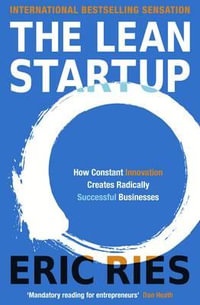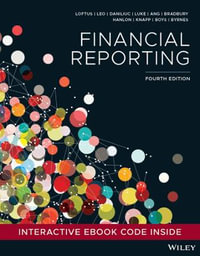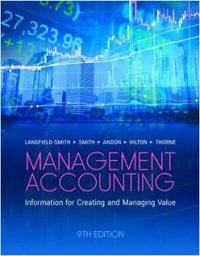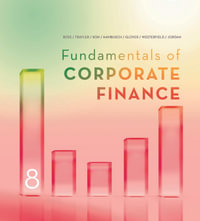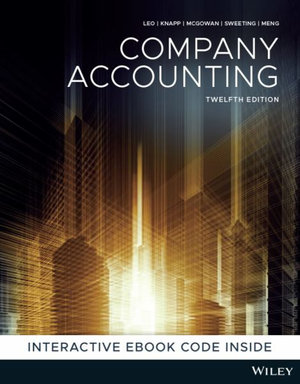
Instant online reading.
Go digital and save!
Company Accounting
12th edition
By: Ken Leo, Jeffrey Knapp, Susan McGowan, John Sweeting, Leah Meng
Paperback | 30 October 2020 | Edition Number 12
At a Glance
864 Pages
Revised
28 x 21.5 x 3
Paperback
RRP $142.95
$123.95
13%OFF
or 4 interest-free payments of $30.99 with
orWhen will this arrive by?
The new edition retains the rigour that Leo’s Company Accounting is renowned for including its logical explanation of techniques, practical application of standards, attention to detail, and depth of analysis.
Available as a full colour printed textbook with an interactive eBook code included, this title enables you to master concepts and succeed in assessment by taking the roadblocks out of self-study, with features designed so you get the most out of learning.
Features
- Currency – Comprehensively updated for new Conceptual Framework
- Jargon-free – Consolidations chapters – present complex material in an understandable way
- Drill and skill – Concept Check questions in the eText are placed at the point of learning, giving you the opportunity to receive immediate feedback and find out how your learning is progressing
Preface xiii
About the authors xiv
Chapter 1 Nature and regulation of companies 1
Introduction 1
1.1 The nature of a company 2
1.2 Different types of companies 3
1.3 Forming a company 6
1.4 Administering a company 8
1.5 Funding a company 9
1.6 Background to the Corporations Act 2001 12
1.7 Accounting regulation of companies 13
1.8 Other important regulatory organisations 24
1.9 General purpose financial reports and the reporting entity concept 26
Summary 31
Key terms 31
Review questions 32
Case study 1 32
Case study 2 32
Case study 3 32
Case study 4 32
Case study 5 33
Case study 6 33
Case study 7 33
Websites 33
References 33
Acknowledgements 34
Chapter 2 Disclosure: legal requirements and accounting policies 35
Introduction 36
2.1 General purpose financial statements 36
2.2 Annual reporting requirements 37
2.3 Half-year financial report 44
2.4 Accounting policies 45
2.5 Changes in accounting estimates 52
2.6 Errors 54
2.7 Impracticability in respect of retrospective adjustments for accounting policy changes or correction of errors 58
2.8 Materiality 58
2.9 Events occurring after the end of the reporting period 60
Summary 62
Key terms 62
Demonstration problem 1 63
Demonstration problem 2 63
Review questions 64
Case study 1 65
Case study 2 65
Case study 3 65
Case study 4 65
Practice questions 65
References 68
Acknowledgements 68
Chapter 3 Disclosure: presentation of financial statements 69
Introduction 69
3.1 A complete set of financial statements 70
3.2 General features of a complete set of financial statements 71
3.3 Statement of financial position 75
3.4 Statement of profit or loss and other comprehensive income 85
3.5 Statement of changes in equity 96
3.6 Notes 99
3.7 Future developments 103
Summary 108
Key terms 108
Demonstration problem 1 109
Demonstration problem 2 113
Review questions 116
Case study 1 116
Case study 2 117
Case study 3 117
Case study 4 117
Case study 5 117
Practice questions 117
Websites 127
References 127
Acknowledgements 127
Chapter 4 Accounting for company income tax 128
Introduction 128
4.1 The benefit of information on current and deferred tax 129
4.2 Income tax in the financial statements 130
4.3 General principles of accounting for income tax 132
4.4 Taxable profit 134
4.5 Current tax 137
4.6 Deferred tax 141
4.7 Tax bases of assets and liabilities 144
Tax base of an asset 144
Tax base of a liability 146
4.8 Temporary differences 147
Excluded temporary differences 149
4.9 Recognition and reversal of deferred tax 150
Deferred tax liabilities 150
Deferred tax assets 151
Summary 159
Key terms 159
Demonstration problem 1 159
Demonstration problem 2 163
Review questions 166
Case study 1 167
Case study 2 167
Case study 3 167
Case study 4 167
Case study 5 167
Case study 6 168
Practice questions 168
Chapter 5 Property, plant and equipment 178
Introduction 178
5.1 The nature of property, plant and equipment 179
5.2 Initial recognition of property, plant and equipment 180
5.3 Initial measurement of property, plant and equipment 182
5.4 Measurement subsequent to initial recognition 187
5.5 The cost model 188
5.6 The revaluation model 195
5.7 Choosing between the cost model and the revaluation model 206
5.8 Derecognition 208
5.9 Disclosure 209
Summary 212
Key terms 212
Demonstration problem 1 212
Demonstration problem 2 215
Review questions 218
Case study 1 219
Case study 2 219
Case study 3 219
Case study 4 219
Case study 5 219
Case study 6 219
Case study 7 220
Case study 8 220
Case study 9 220
Practice questions 220
References 227
Acknowledgements 227
Chapter 6 Foreign currency transactions and forward exchange contracts 228
Introduction 229
6.1 The need for translation of foreign currency amounts 230
6.2 The means of translation: exchange rates 232
6.3 Foreign exchange differences 233
6.4 Accounting for foreign currency monetary items 235
6.5 Exchange differences for non-monetary items 243
6.6 Foreign exchange risk 247
6.7 Forward exchange contracts without hedging 248
6.8 Forward exchange contracts with hedging 252
6.9 Disclosures 259
Summary 261
Key terms 261
Demonstration problem 1 262
Demonstration problem 2 263
Review questions 264
Practice questions 264
Acknowledgement 269
Chapter 7 Business combinations 270
Introduction 270
7.1 The nature of a business combination 271
7.2 Accounting for a business combination — basic principles 273
7.3 Accounting in the records of the acquirer 276
7.4 Recognising and measuring assets and liabilities 277
7.5 Accounting in the records of the acquirer 282
7.6 Accounting by the acquirer: shares acquiredin an acquiree 292
7.7 Accounting in the records of the acquiree 293
7.8 Subsequent adjustments to the initial accounting for a business combination 296
7.9 Disclosure — business combinations 299
Summary 304
Key terms 304
Demonstration problem 1 304
Demonstration problem 2 306
Review questions 309
Case study 1 309
Case study 2 310
Case study 3 310
Case study 4 310
Case study 5 310
Practice questions 311
References 320
Acknowledgements 320
Chapter 8 Impairments of assets 321
8.1 Introduction to AASB 136/IAS 36 321
8.2 When to undertake an impairment test 323
8.3 Impairment test for an individual asset 325
8.4 Cash-generating units — excluding goodwill 333
8.5 Cash-generating units and goodwill 339
8.6 Reversal of an impairment loss 344
8.7 Disclosure 348
Summary 352
Key terms 352
Demonstration problem1 352
Demonstration problem 2 354
Review questions 356
Case study 1 356
Case study 2 356
Case study 3 356
Case study 4 357
Case study 5 357
Case study 6 357
Case study 7 358
Case study 8 358
Case study 9 358
Case study 10 358
Case study 11 359
Case study 12 359
Case study 13 359
Practice questions 359
References 366
Acknowledgements 366
Chapter 9 Consolidation: controlled entities 367
Introduction 367
9.1 Consolidated financial statements 368
9.2 Control as the criterion for consolidation 370
9.3 Preparation of consolidated financial statements 376
9.4 Investment entities 378
9.5 Business combinations and consolidation 379
9.6 Disclosure 381
IFRS 12 381
Summary 384
Key terms 384
Review questions 384
Case study 1 385
Case study 2 385
Case study 3 385
Case study 4 385
Case study 5 386
Case study 6 386
Case study 7 386
Case study 8 386
Case study 9 386
Case study 10 387
Case study 11 387
Case study 12 387
Case study 13 388
Case study 14 388
Case study 15 388
Case study 16 388
Acknowledgements 388
Chapter 10 Consolidation: wholly owned subsidiaries 389
Introduction 389
10.1 The consolidation process 390
10.2 Consolidation worksheets 391
10.3 The acquisition analysis 392
10.4 Worksheet entries at the acquisition date 396
10.5 Worksheet entries subsequent to the acquisition date 401
10.6 Revaluations in the records of the subsidiary at acquisition date 412
10.7 Disclosure 413
10.8 Reverse acquisitions 415
Summary 418
Key terms 418
Demonstration problem 1 418
Demonstration problem 2 422
Review questions 426
Case study 1 427
Case study 2 427
Case study 3 427
Case study 4 427
Case study 5 428
Practice questions 428
Acknowledgement 434
Chapter 11 Consolidation: intragroup transactions 435
Introduction 436
11.1 Rationale for adjusting for intragroup transactions 436
11.2 Transfers of inventories 438
11.3 Transfers of property, plant and equipment 446
11.4 Transfers between inventories and non-current assets 453
11.5 Intragroup services 456
11.6 Intragroup dividends 458
11.7 Intragroup borrowings 461
Summary 465
Key terms 465
Demonstration problem 1 465
Demonstration problem 2 471
Review questions 475
Case study 1 475
Case study 2 476
Case study 3 476
Case study 4 476
Practice questions 476
Acknowledgements 487
Chapter 12 Consolidation: non-controlling interest 488
Introduction 488
12.1 Nature of the non-controlling interest (NCI) 489
12.2 Effects of NCI on the consolidation process 492
12.3 Calculating the NCI share of equity 500
12.4 Effects of intragroup transactions on NCI 510
12.5 Gain on bargain purchase 514
Summary 516
Key terms 516
Demonstration problem 1 516
Review questions 526
Case study 1 527
Case study 2 527
Case study 3 527
Case study 4 527
Practice questions 528
Acknowledgements 537
Chapter 13 Consolidation: indirect ownership interests 538
Introduction 538
13.1 Wholly owned groups with multiple subsidiaries 539
13.2 Direct and indirect non-controlling interest 542
13.3 Calculating the NCI share of equity where the group has DNCI and INCI 543
13.4 The effects of goodwill on the calculation of NCI 548
13.5 The effects of the business combination valuation entries on the calculation of NCI 550
13.6 The effects of intragroup transactions on the calculation of NCI 554
13.7 The effects of dividends on the calculation of NCI 556
Summary 559
Key terms 559
Demonstration problem 1 559
Demonstration problem 2 571
Review questions 576
Case study 1 576
Case study 2 576
Case study 3 577
Practice questions 577
Acknowledgement 587
Chapter 14 Consolidation: the statement of cash flows 588
Introduction 588
14.1 Format of the statement of cash flows 590
14.2 Cash and cash equivalents 592
14.3 Classification of cash flows 593
14.4 The reconstruction of accounts approach 596
14.5 Reconciliation of profit for the year to net cash from operating activities (indirect method of presentation) 605
14.6 Consolidated statement of cash flows following acquisition of a subsidiary 607
14.7 Consolidated statement of cash flows following disposal of a subsidiary 613
14.8 Note disclosures 619
14.9 Additional issues 620
Summary 625
Key terms 625
Demonstration problem 1 625
Review questions 631
Case study 1 632
Case study 2 632
Case study 3 632
Case study 4 633
Practice questions 633
References 651
Acknowledgements 651
Chapter 15 Consolidation: translation of financial statements into functional and presentation currency 652
Introduction 652
15.1 Why translating financial statements is necessary 653
15.2 Functional and presentation currencies 656
15.3 From functional currency to translation process to translation method 661
15.4 Translation into the functional currency — the temporal method 662
15.5 Translation from the functional currency into the presentation currency — the current rate method 669
15.6 Translation of cash flows 674
15.7 Consolidation of translated financial statements 676
15.8 Disclosure 677
Summary 679
Key terms 679
Demonstration problem 1 679
Review questions 683
Case study 1 683
Case study 2 683
Case study 3 684
Case study 4 684
Case study 5 684
Practice questions 685
References 695
Acknowledgements 695
Chapter 16 Joint arrangements: accounting for joint operations 696
Introduction 696
16.1 The characteristics of joint arrangements 698
16.2 The classification of a joint arrangement 700
16.3 Accounting for joint arrangements 705
16.4 Accounting by the joint operation itself 707
16.5 Accounting by a joint operator 709
16.6 Disclosure 720
Summary 722
Key terms 722
Demonstration problem 1 722
Review questions 725
Case study 1 725
Case study 2 725
Case study 3 726
Case study 4 726
Practice questions 726
References 734
Acknowledgements 734
Chapter 17 Accounting for associates and joint ventures 735
Introduction 735
17.1 Identifying associates and joint ventures 737
17.2 The equity method of accounting: rationale and application 741
17.3 Applying the equity method: basic principles 743
17.4 Applying the equity method: goodwill and fair value adjustments 748
17.5 Applying the equity method: inter-entity transactions 755
17.6 Share of losses of the associate 763
17.7 Applying the equity method: other issues 765
17.8 Disclosure 769
Information in the financial statements 771
Information in the financial statements 771
Summary 774
Key terms 774
Demonstration problem 1 774
Review questions 780
Case study 1 780
Case study 2 781
Case study 3 781
Case study 4 781
Practice questions 781
References 791
Acknowledgements 791
Chapter 18 Insolvency and liquidation 792
Introduction 792
18.1 Insolvency and administration 793
18.2 Winding up in insolvency and by the court 796
18.3 Voluntary winding up 798
18.4 Powers of the liquidator 804
18.5 Proof of debts 805
18.6 Priority of payment of debts 805
18.7 Rights of contributories (members or shareholders) 808
18.8 Accounting for liquidation 812
18.9 Receivership 817
Summary 820
Key terms 820
Demonstration problem 1 821
Demonstration problem 2 823
Demonstration problem 3 826
Review questions 828
Case study 1 829
Case study 2 829
Practice questions 829
Acknowledgements 841
Index 842
ISBN: 9780730382676
ISBN-10: 0730382672
Published: 30th October 2020
Format: Paperback
Language: English
Number of Pages: 864
Audience: College, Tertiary and University
Publisher: John Wiley & Sons Australia
Country of Publication: AU
Edition Number: 12
Edition Type: Revised
Dimensions (cm): 28 x 21.5 x 3
Weight (kg): 1.7
Shipping
| Standard Shipping | Express Shipping | |
|---|---|---|
| Metro postcodes: | $9.99 | $14.95 |
| Regional postcodes: | $9.99 | $14.95 |
| Rural postcodes: | $9.99 | $14.95 |
How to return your order
At Booktopia, we offer hassle-free returns in accordance with our returns policy. If you wish to return an item, please get in touch with Booktopia Customer Care.
Additional postage charges may be applicable.
Defective items
If there is a problem with any of the items received for your order then the Booktopia Customer Care team is ready to assist you.
For more info please visit our Help Centre.
You Can Find This Book In

Blue Ocean Strategy, Expanded Edition
How to Create Uncontested Market Space and Make the Competition Irrelevant
Hardcover
RRP $54.99
$38.35
OFF

